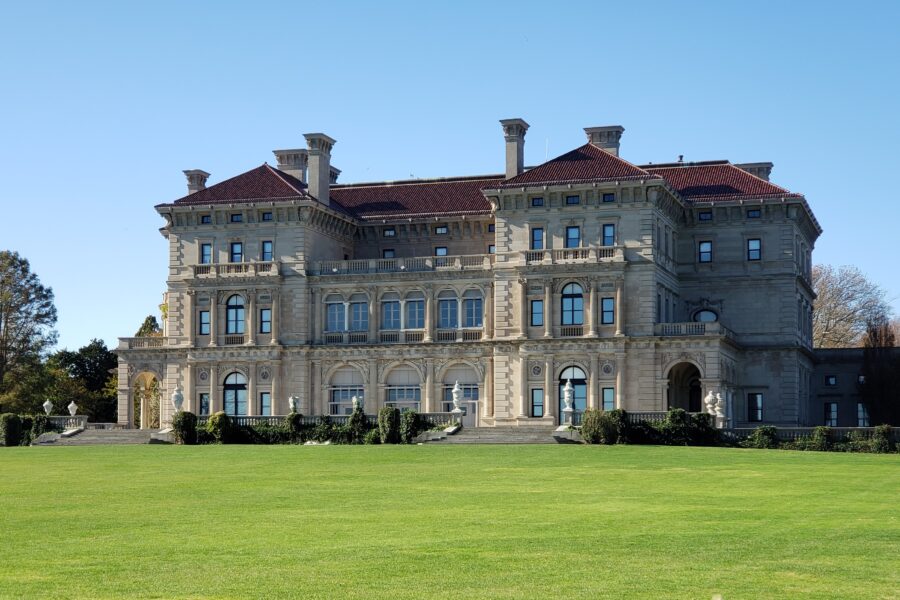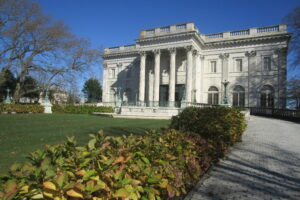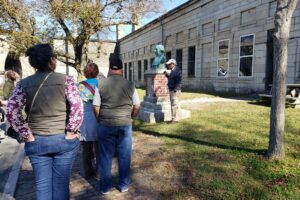Continuing our journey along Ocean Drive, we come to the area of Newport where the Gilded Age summer cottages of the very wealthy stand today. Behemoths of a period in our history that represented conspicuous consumption, gross materialism and blatant political corruption during the 1870s. But still we are drawn to the time and the places they lived. The era of the Great Gatsby’s of the world. Daring ourselves to dream. The Breakers, built by a third generation Vanderbilt, is the grandest of the grand.
The Cliff Walk
Our intentions are to take an autumnal stroll on the Cliff Walk that borders the back lawn of these grand estates, and see what we can see.



When we arrive at the Breakers, I see many individuals strolling on the grounds. And, I see a place to exit the Cliff Walk. A road to follow. A gate to enter. Without too much forethought we are here. I did read that if you were only going to see one Newport mansion, the Breakers is the one to see.


The Breakers Tour

We pay $27 each, are handed our headsets attached to a smartphone-like device, and begin. We step into a palace. It is a posh world of ivory and gold, adorned with touches of pink marble. Deep red carpeting runs up the marble staircase and drapes the windows that look toward the sea. The ceilings soar skyward, reaching a height of 45-feet. It is the most splendid of elegant ballrooms, built to impress and entertain. It is the Great Hall.


The Cottage that Cornelius Vanderbilt Built
We wander on, stopping in front of a portrait of the man who built this summer cottage—an absurd description of something so palatial. Cornelius Vanderbilt II, built the Breakers only after the original Queen Anne style wooden summer house he purchased for $450,000 was destroyed by fire. Vanderbilt wanted his new summer home to be built of something virtually fireproof.
He wanted stone and marble, and that is what he got.

This mansion is immense. Seventy rooms. Over 62,000 square feet of living space; and another 62,857 somewhere, for what I can only guess. The entire foot print of the cottage takes up one acre of land, with an additional thirteen acres devoted to grounds, much of the lawn and gardens overlooking the vast blue world of the Atlantic Ocean. This is a back yard for entertaining in very high style; one I wouldn’t mind having at my disposal for a Texas style barbecue.
The recording informs me that this house was built in only two years. That is something beyond amazing. They must have had at least 1,000 laborers working day and night, and an army of skilled artisans working equally as long. The audio guide doesn’t tell me the number of workers, and I am not sure if I can find the answer even if I look. And the cost? Over $7,000,000 in 1895 ($213,965,833 in 2019). An extreme case of conspicuous consumption.
The Public Rooms
We wander from public room to public room listening attentively to the audio tour. At times taking longer than normal to hear extra anecdotes and information.
The craftsmanship, the materials, are jaw-droppingly gorgeous. Hand painted platinum panels in one room, tooled gold leaf to look like old leather in another.
Many of the rooms were built in Europe, shipped to Newport and reassembled.








During the tour we discover, as is the case of many old mansions of the Gilded Age, that these edifices are white elephants. They are beyond affordable to keep and to keep-up; often sold at a fraction of their cost or else given away. The Newport summer cottage known as the Breakers, that Cornelius Vanderbilt spent $7,000,000 to build in 1895, along with approximately 90% of its furnishings, was sold to the Preservation Society in Newport in 1972 for $365,000 ($2.2 million in 2019).
The Private Rooms
Our tour leads us up the back-stairway to the private rooms on the second floor. When we arrive it is like walking into a peaceful oasis after being bombarded with excess. Understated, quiet elegance. Almost livable.
Entering the bedroom of Cornelius Vanderbilt, we learn that he was only able to enjoy one healthy summer at the Breakers. Vanderbilt had a stroke one year after this mansion was completed, dying of a cerebral hemorrhage three years later at the age of 55.



The Kitchen
My favorite room of the Breakers is the kitchen. No surprise, since the kitchen seems to be where people hang out when visiting me — or my friends. This kitchen is where the servants gathered and gossiped and it is filled with copper and light. I can imagine the hustle and bustle. Smell savory beef being roasted in the oven. The aroma of warm bread wafting upward.


A Gift I Give Myself
On our way out of the Breakers we pass through a long hallway lined with things I could fall in love with. I see one, a beautiful serving tray with acorn handles. Perfect for two people for happy hour. When I reach the gift shop, I look for this tray and I find two—one small, one larger. Much to Michael’s chagrin (he thinks serving trays equal big parties) I buy both. I guess I have a small case of conspicuous consumption myself. 🙁

My packages and I wait for Michael at the entrance to the parking lot while he walks to get the car which is parked blocks away near one of several entrances to the Cliff Walk.
Thames Street and Dinner

In the car, Google Maps returns us to where this adventure started early this morning, Thames Street. We hope that dinner awaits — somewhere. Michael chooses the first restaurant he sees, but walking in the door, we are both unhappy with the seating options. There are only stools. No chairs with backs.
We walk across the street to the Red Parrot. We are pleased at the prices on the menu. Compared to every other restaurant we visit, they are more than reasonable.
I order onion soup one more time and a flatbread made with fig jam, goat cheese, and arugula. The onion soup is good, not great. The flatbread is a disappointment. Too sweet (too much fig jam) poor quality tasteless goat cheese, limp arugula. Michael orders lobster bisque and a sandwich. I taste his lobster bisque and one bite is more than enough. Finishing our meal, we realize once again—you get what you pay for.



The Vanderbilt’s and Their Fortune
Michael and I have seen Vanderbilt Mansions in the Hudson River Valley, North Carolina and in Rhode Island. The most understated was in the Hudson River Valley, built by a disinherited son who made his own way in the world. During that tour we heard the faintest inkling of, “… the rest of them spent it, ALL.”
In a Nutshell…
Imagine if you will, a young man borrowing a $100 from his mother in 1810 so that he could pilot a passenger boat on Staten Island, then expanding his business to include steamships and railroads that crisscrossed the US. By the time the young man grew old and died in 1877 he turned that $100 into $100,000,000 ($245,000,000,000 in 2019), which was more than was in the US Treasury at the time.
This entrepreneur left his fortune to one son who doubled it to $200,000,000, leaving two sons to inherit from him. One of them built The Breakers in Newport. The original inheritance stopped growing because of the decline in steamships and railroads while the descendants kept increasing in numbers and increasing their spending. And then there was none… It makes you think, doesn’t it?
To read more, click on this link. https://www.forbes.com/sites/natalierobehmed/2014/07/14/the-vanderbilts-how-american-royalty-lost-their-crown-jewels/#77331992353b














1 Comment
Leave your reply.